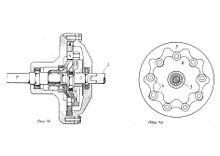Lorenz Braren
Lorenz Konrad Braren (born May 30, 1886 in Borgholz near Heide (Holstein) ; † February 7, 1953 in Markt Indersdorf ) was a German designer , entrepreneur and genealogist.
Life
Lorenz Braren was born on May 30, 1886 in Borgholz to parents Ida Maria and Brar Cornelius Braren. Both came from the North Sea island of Föhr ; the amateur painter Oluf Braren was his great-great-uncle. After attending the elementary school in Lundenberg and after graduating from the Hermann Tast School in Husum , where the family had moved, Lorenz Braren first hired on a steamer on the Hamburg-America Line in 1903 , then switched to a traineeship a locksmith's shop and machine factory, before he went to relatives in America in 1906 after completing his military service in the shipyard division. In New Jersey he first found work in a steel mill and eventually became a department manager in a foundry.
Returned to Germany in August 1910, he began studying at the Hamburg technical center. After graduating, he became engaged to Lisbeth Piper in 1911 and from 1912 onwards, during a second stay in America, initially worked in a company that manufactured industrial sewing machines until he was employed as a draftsman at a crane building company in Muskegon . In 1913, Lorenz Braren married Lisbeth Piper in Jersey City . In 1920 she returned to Germany with her three children, Keike, Brar and Rudolf, who had now been born, where her third son, Lorenz, was born that summer. Six months later, Lorenz Braren followed his family to Husum. He worked on the design of a wind turbine and received a patent for an automatic cutting machine that had already been developed in the USA .
In June 1922, Lorenz Braren became chief designer at the Friedrich Deckel company in Munich , with whose owner he had a close cooperation and friendship. In 1923 his youngest child, Lisbeth, was born. Braren received patents for copy milling machines, as they are still in operation today in Val Gardena ( South Tyrol ) for the production of nativity figures, and developed gears such as the Compur gearbox. Between 1927 and 1930, this transmission, which was eventually given the name Cyclo, was further developed, for which it was again granted a patent. In 1931 Lorenz Braren founded the Deutsche CYCLO Lorenz Braren KG at Dachauer Straße 114 in Munich and manufactured the first gearboxes, which were also exhibited at the Leipzig trade fair in 1932 . There he was able to initiate a license to a Japanese company that belongs to today's Sumitomo Heavy Industries group in 1937 .
From 1938 onwards CYCLO developed gearboxes for aircraft from Dornier-Werke , Junkers & Co. and Focke-Wulf , but also Fokker , Ernst Heinkel Flugzeugwerke and Messerschmitt AG were among the customers. The number of employees in the company grew to over 500 by the end of 1940, and finally to almost 1,000. In 1944 the CYCLO factory in Munich was almost completely destroyed by a bomb attack. After the war ended in 1945, production slowly increased again and in 1949 a new building was inaugurated in Markt Indersdorf north of Munich. Thanks to the Japanese licensee, Brarens gear units achieved market leadership in Asia, and Lorenz Braren also intensified sales in the USA, South America and the Eastern Bloc countries at the time.
Lorenz Braren died on February 7th, 1953 in Markt Indersdorf and, according to his wishes, was buried on the island of Föhr in the cemetery of the church of St. Laurentii (Süderende) . On August 5, 1973, not far from there, the North Frisian Association inaugurated a Lorenz Braren memorial near Monklembergem. Lorenz-Braren-Strasse in Markt Indersdorf is named after him.
Genealogy and ethnicity research
Lorenz Braren had been making notes about his home island of Föhr since 1906. These eventually develop into a three-volume work, the "Gender Series St. Laurentii Föhr", which contains the life data of over 20,000 people and information on family relationships. With his Lorenz Braren Foundation, Lorenz Braren donates legacies, the proceeds of which benefit the Frisian homework. Lorenz Braren also founded the Utersum costume group, which existed for 60 years in 2011, and promoted their participation in the costume parade to the Munich Oktoberfest .
literature
- Lorenz Braren: Gender series St. Laurentii-Föhr, part I-III. Husum Druck- und Verlagsgesellschaft, Husum 1980 (reprint), ISBN 978-3-88042-092-2
- Brar C. Roeloffs: Farmers, sailors and emigrants from the island of Föhr. Gender series St. Laurentii-Föhr, part IV. Husum Druck- und Verlagsgesellschaft, Husum 2007 ISBN 978-3-89876-291-5
swell
- Christian Brar Keller, Lorenz Braren: For the 125th birthday . Eichenau 2011
- Manufacturer and researcher. Lorenz Braren (1886–1953), in: Eilunsfresken - Inselfriesen. Life pictures from North Friesland by Jakob Tholund. North Frisian résumés 4. Ed. By Thomas Steensen, Verlag Nordfrisk Instituut, Bredstedt o. J.
Web links
| personal data | |
|---|---|
| SURNAME | Braren, Lorenz |
| ALTERNATIVE NAMES | Braren, Lorenz Konrad |
| BRIEF DESCRIPTION | German designer, entrepreneur and genealogist |
| DATE OF BIRTH | May 30, 1886 |
| PLACE OF BIRTH | Borgholz |
| DATE OF DEATH | 7th February 1953 |
| Place of death | Market Indersdorf |
